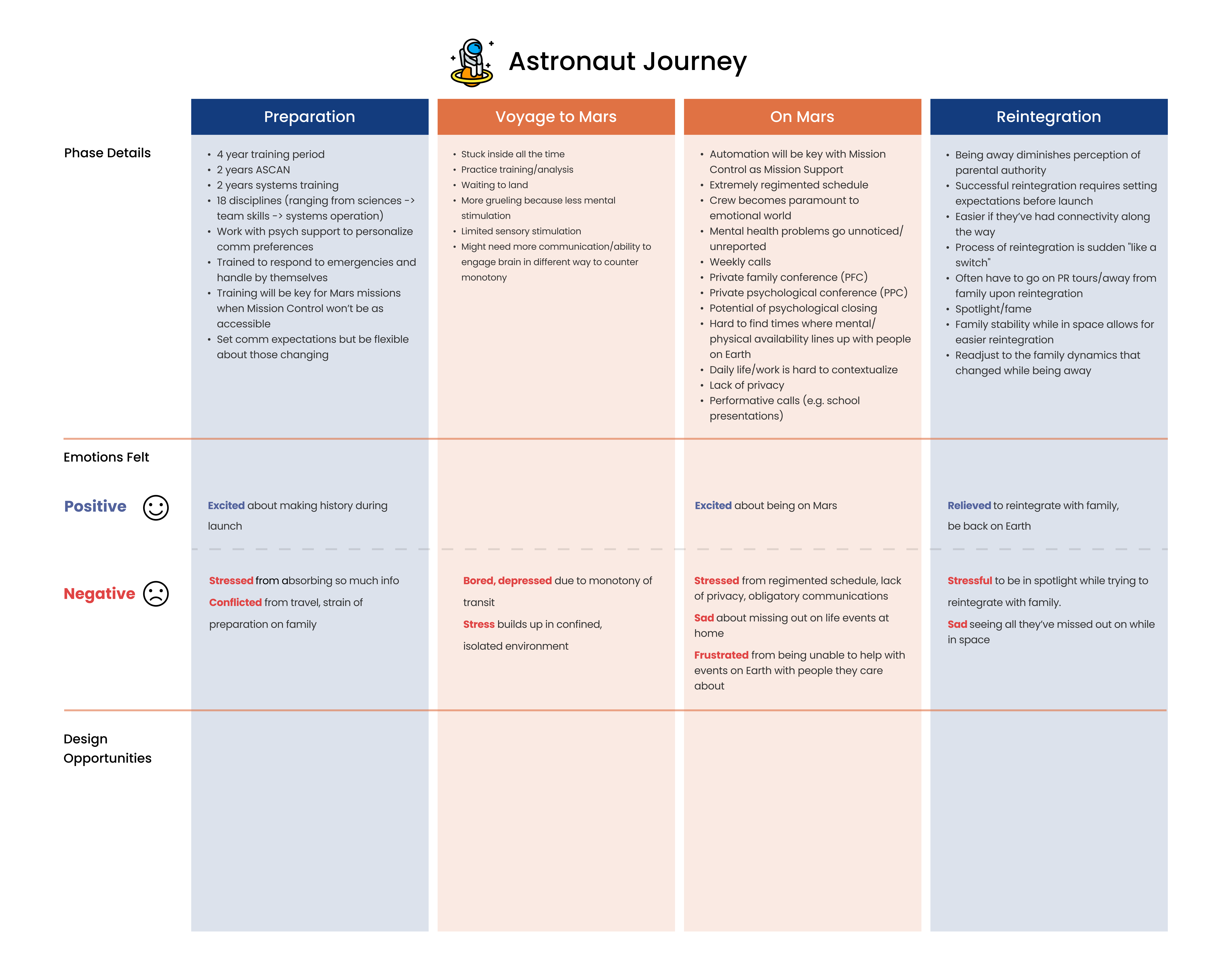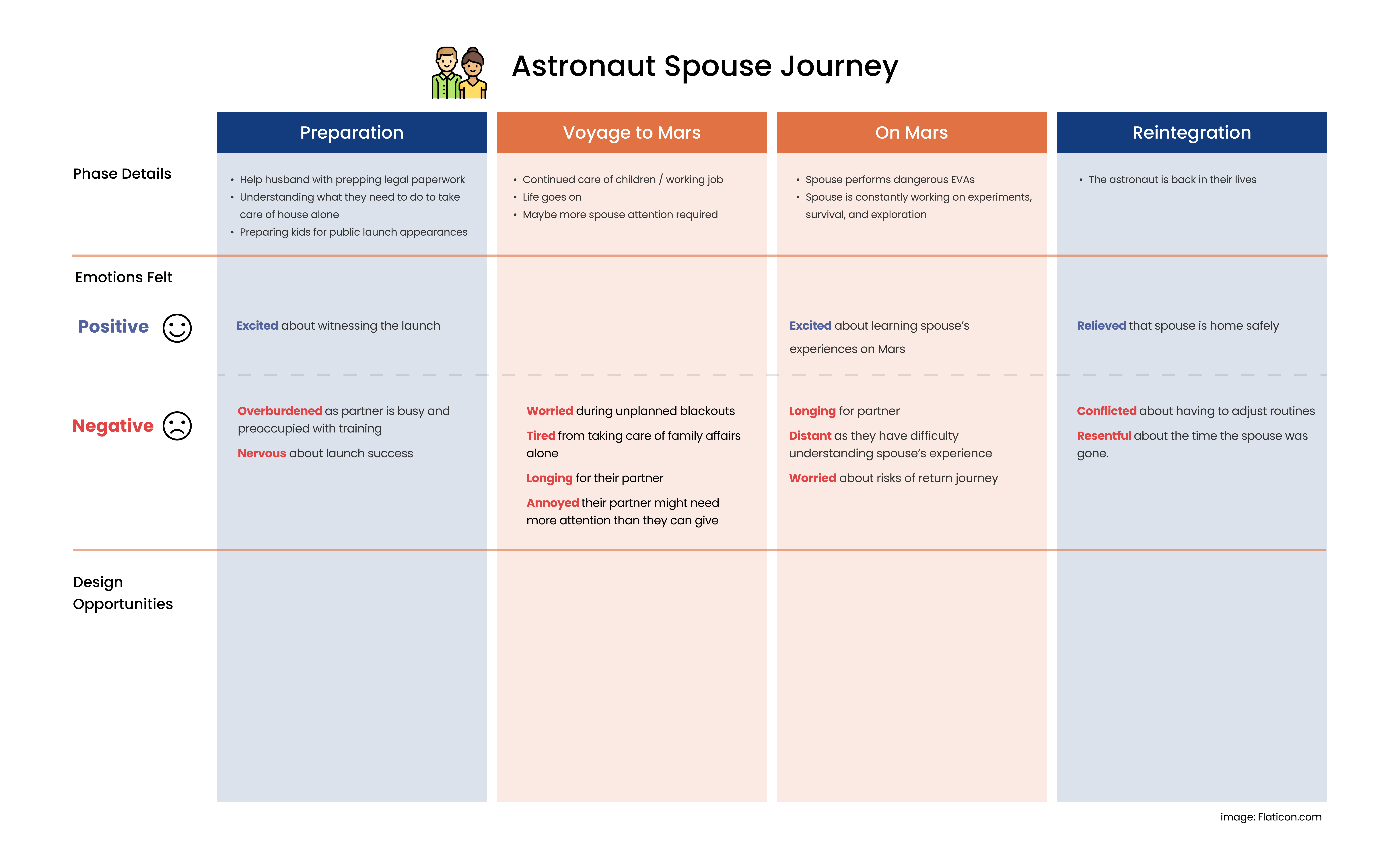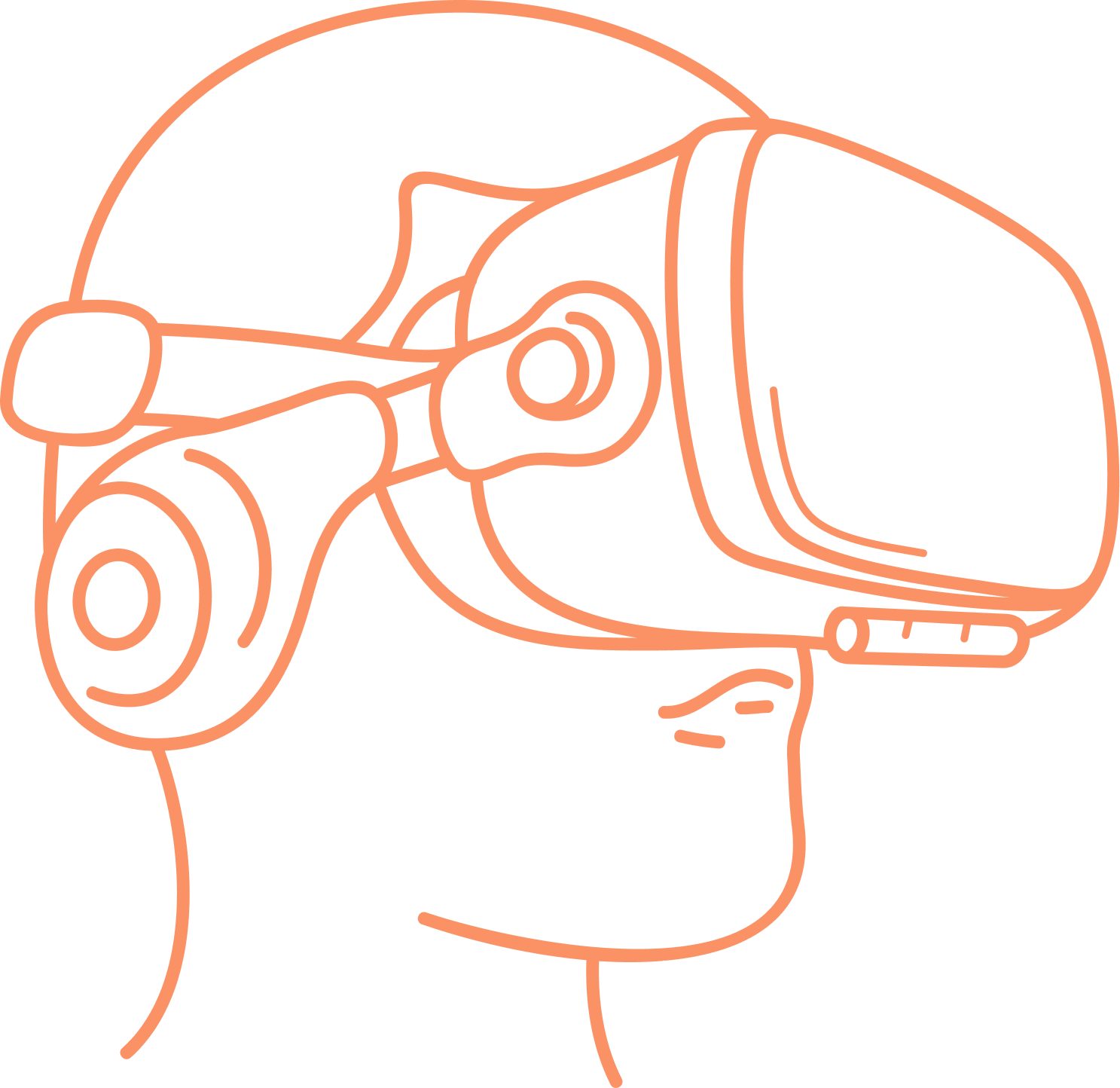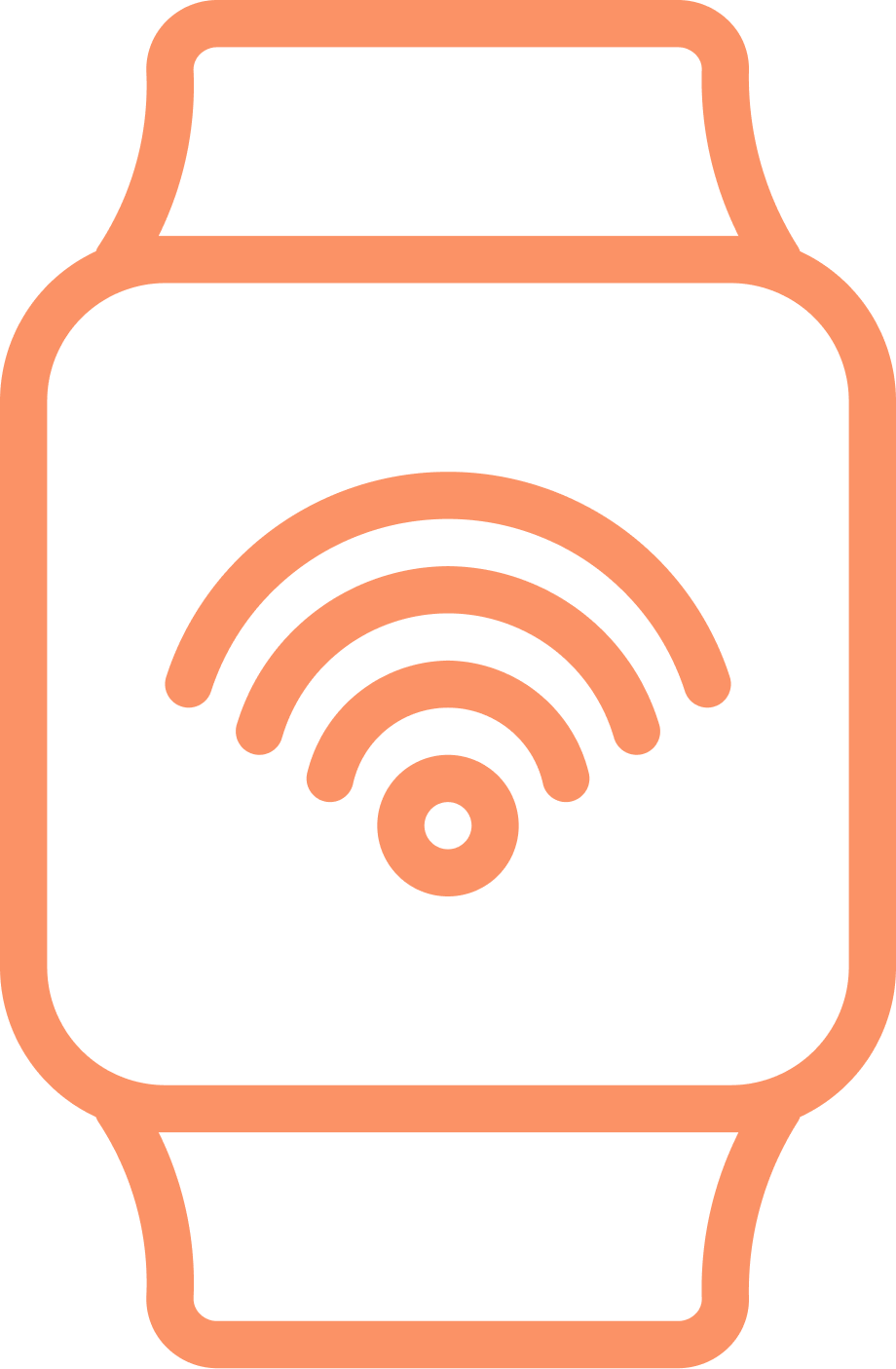One of our primary research questions aimed to understand who astronauts consider meaningful in their lives. It was important to identify and hear the perspectives of these people because they make up the other side of our users, aside from astronauts, who would interact with our solution.

From our initial interviews, it was apparent that communication between astronauts and those on Earth involves a complicated network of people. To help identify the people with whom astronauts have the most contact, we created a stakeholder map modeled in concentric circles to denote their level of communication with the astronaut. The dashed lines provide a mental model of how information flows outward from the astronaut through stakeholders in different lines of communication.
Mapping out the entire experience from preparation to reintegration reveals stages where astronauts confront the most challenges with communication, providing opportunity areas for us to address with our design solution.

From the astronaut journey map, it is evident that the period of time astronauts spend on Mars is the most challenging part of their journey. At this point, they are stressed from their regimented schedules, lack of privacy, and the burden of obligatory communication. They have also been away from their family and become increasingly sad about missing out on life events and frustrated over a sense of powerlessness from space.
We also mapped out the parallel journey for an astronaut's spouse, who experiences the same phases of the journey but with different stressors on Earth. We thought it was important to consider the spouse's perspective in particular because every interview participant had mentioned their spouse when asked about communication with meaningful people.

The following barriers of meaningful communication refer to factors that were widely identified as pain points in the communication between astronauts and their loved ones across all of our research findings.
These barriers will be inevitable, since we cannot change the reality that astronauts will be apart from their loved ones, their expectations as an astronaut, or NASA's privacy policies. However, our design solution aims to address these barriers by incorporating elements that help reduce the negative effects they pose on communication.
Click through the icons to learn more about each barrier
“Going on a long space flight is like...reading a book...when you deploy, you put a bookmark in. Once you come back...the family has moved on. They didn't put up bookmarks and they have read on.”
Astronauts feel increasingly disconnected from their loved ones as they find it difficult to relate to the other’s experiences, miss out on life events, and feel powerless over what is going on at home. This ends up closing off an important line of communication.
Providing conversation topics and encouraging both sides to share life details can help keep this line of communication open.
"…you’re literally giving pieces of yourself away to people all the time."
Communication can feel burdensome or obligatory especially in instances when it is performative or only for the sake of communicating.
Beyond the performative celebrity aspect of being an astronaut, even communicating with family members can be overwhelming depending on your mental and physical availability. It is mentally taxing to keep people entertained or find topics to talk about under the tremendous cognitive burden astronauts are already under.
“We’ve been talking…every day, but too often our conversations are just passing information exchanges inconveniently timed around too many listening ears for quality, in-depth communication.”
Concerns with privacy and trust was an unexpected barrier we uncovered through candid conversations with interview participants. We found that astronauts find it difficult to be open and vulnerable with loved ones because they are being monitored. The main concern is that sharing their mental health status could impact their flight status for future missions.
This directly impacts relationships, since astronauts have to be weary of what they share with those who they would typically talk about their emotions, feelings, and frustrations with.
When we asked astronauts and analogous domains about what makes an interaction meaningful, the following 4 factors were commonly present in the communication experiences they identified as meaningful. These bolsters are what we categorize as needs in maintaining meaningful communication.
Click through the icons to learn more about each bOLSTER
"It’s hard to communicate with teenage kids in space or not. But like exchanging who got the Wordle and how many lines and all those little types of connections is nice."
Shared activities provide a context for astronauts and their loved ones to bond over and can build empathy between both parties. Since many interview participants revealed that not being able to relate to their family members, particularly children, causes strain on those relationships, we asked about methods they used to passively stay connected, where explicit dialogue between the two parties was not required.
Our interview participants resorted to different forms of entertainment to keep them preoccupied with minimal effort required. This could look like watching a movie together, sharing music, playing a game, or engaging in other activities both parties enjoy. Our solution could draw inspiration from these ideas, compiling all of them into one engaging platform to provide a multitude of options.
"I don’t get to watch my son grow up, so learning about small events makes me feel involved."
Keeping up to date with the small details in your loved ones' lives is critical for maintaining a meaningful relationship with them. Being away from home means that astronauts and their family members no longer share the small nuances of their everyday lives that are naturally exchanged when living together. Adding on the compounded factors of distance, time, and psychological stressors of being in space, knowing these small details will be particularly helpful for making astronauts feel connected and included from Mars.
However, not only is the general act of sharing small details important, but the way in which they are shared carries equal importance. Our interview participants explained that the method of sharing should feel intimate and personal to the person who is sharing them. For example, sending photos back and forth of your day is not meaningful without the story and context behind the significance of the detail.
“You get kind of that monotony over time. Same activities, same people, same conversations. It’s a lack of novelty and mental and emotional stimulation.”
Providing and preserving an aspect of novelty will be essential throughout the mission, especially during the 6-8 month transit periods. In transit, astronauts will be subject to the monotony of never-ending darkness and regimented daily routines, which can be psychologically grueling. As a result of the lack of novelty and sensory stimulation of this stage, astronauts will look to their communications with loved ones to fulfill this need for novelty.
On top of the monotony of space travel in general, relationships have the potential of becoming monotonous as well, especially with regard to the conversation that is shared on a day-to-day basis. It will be important to have new avenues of conversation or experiences to relate to each other with to combat this overall monotony.
"It’s starting to bother her that she no longer remembers how I feel or smell…she is craving real human touch…she wants something so simple and I can’t give it to her."
As humans, sensory experiences are crucial for our physical and mental health. While astronauts are confined in their extreme, isolated environment for 3 years, there is a high risk of developing adverse behavioral conditions and psychiatric disorders due to a lack of sensory stimulation. Sensory stimulation also has the power to carry memories with them and foster connectedness. From our interview participants, we learned that mediums of communication where they could hear the sound of someone's voice or see their handwriting made them feel closer to their loved ones.
For astronauts, sensory cues allow them to better read the emotional states of their loved ones.
Our solution should consider the psycho-physiological effects that astronauts will undergo on Mars. In addition, keeping in mind all of the other stressors on their relationships, our solution should generally aim to preserve astronauts' autonomy but reduce their cognitive load by adhering to the following 3 requirements:

One of the biggest physical challenges that astronauts endure is degradation of visual and motor abilities caused by exposure to high levels of radiation and CO2. This causes bone mass loss and visual impairments, which could make it difficult to do things like type on a keyboard, tap on certain buttons, or look at a screen for too long.

Having an intuitive design is particularly important in the context of space travel because astronauts are already required to remember an overwhelming amount of information, such as knowledge of how to use all of the machines on board. To avoid adding to their mental load, our solution should be easy to use and demand minimal effort from the user.

The high radiation level can also be damaging to technology over time. Since the systems going up to Mars will be the only available technology throughout the journey, our solution should prepare for the possibility that some technology may stop functioning, meaning that certain mediums of communication will no longer be reliable for use.
Taking our barriers and bolsters to meaningful communication into consideration along with the established technical requirements, we plan on moving forward with 4 possible solution directions. These solution directions have the potential to address all of these factors, so they will be parallel prototyped and iterated upon, extracting the best features of each prototype, until we ultimately piece them together to develop an effective, comprehensive solution.

The idea for collaborative games was in response to the user need for shared activities and novelty. Collaborative games help bridge the disconnect between astronauts and their family members by providing that shared experience between the two. This alleviates the need to figure out what to talk about, and it relates back to the story of playing Wordle as a way to passively stay connected with a loved one. Games can also introduce some novelty and fun into the monotony of astronauts’ daily regimented routines.
Our gravitation towards VR is informed by the user need for novelty and sensory experiences. VR has the opportunity to provide a perceived sense of connectedness– for example, if you could partake in a virtual activity with a family member. But, VR can also allow astronauts to escape the reality of their situation by taking “vircations” (virtual vacations). This could be particularly helpful during the period of transit back home, when morale is low and psychological health has diminished.


From our research, we consistently heard that communication varies between individuals: what’s discussed, what’s perceived as meaningful, what’s draining, etc.– all of these factors are not only dependent on the user’s unique personality, but also on their mental and emotional availability. A holistic platform would provide astronauts with a wide range of ways to communicate with their family members and the flexibility to choose which form of communication fits best with their current needs.
This design idea is informed by the user need of sensory experiences. We believe that having some form of ambient or abstracted presence may help foster a sense of closeness between parties. While we had only tested this idea with one storyboard that explored a parent-child relationship, we want to keep pushing this concept and validating its value for partner-partner relationships.
